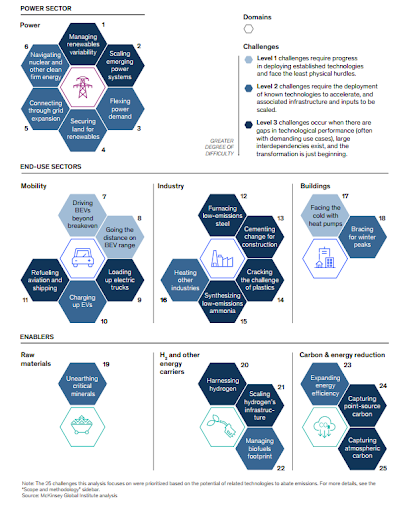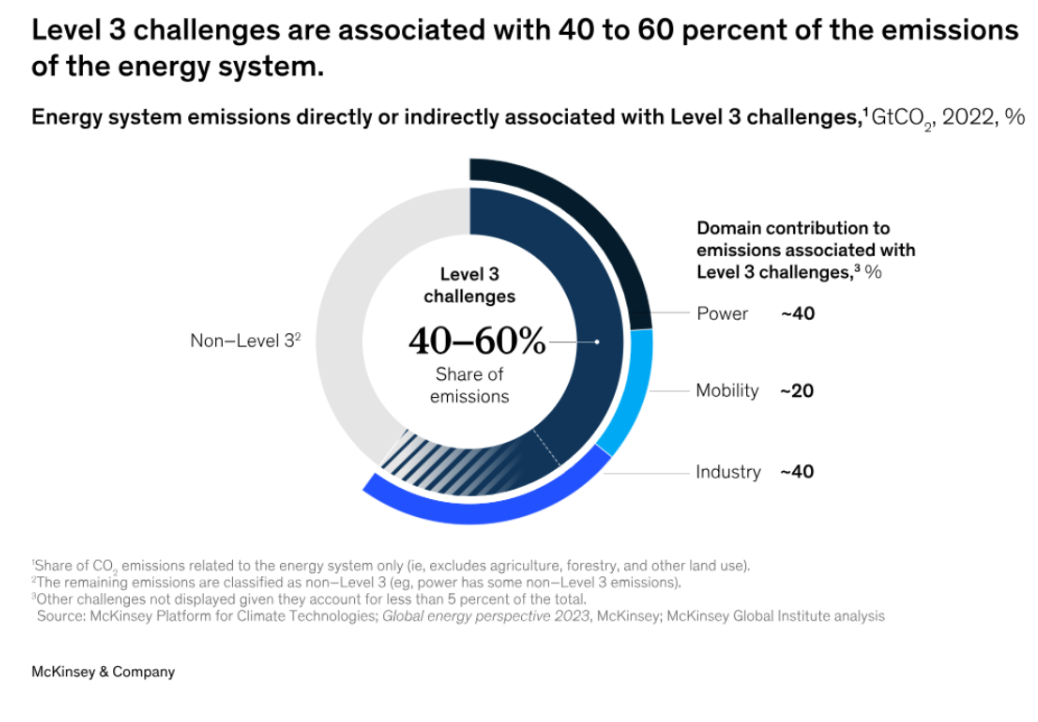The energy transition has physical barriers. How to navigate them?


· 6 min read
The current energy system is a complex and interlinked system, both in terms of consumption and production. It has only been able to achieve only 10% of the target set for emission reduction by 2050. Throughout the years, the energy system has been optimized in order to serve billions, which was made possible owing to the energy-dense fuels that can be transported with ease. On the other hand, this efficiency comes with its costs; two-third of the energy produced is wasted in the transportation process and the system has an 85% carbon emission as of now. The system is heavily dependent on fossils, which make 80% of its base consumption. The global community is met with the challenge of transitioning to a low-emission energy system, and “holding the increase in the global average temperature to well below 2°C above preindustrial levels and pursuing efforts to limit the temperature increase to 1.5°C above preindustrial levels.” Moreover, the emission reduction is coupled with another task; ensuring the growth of the current energy system to serve larger number of people.
In the attempt to reach a sustainable energy system with low-emission, its physical aspects must be considered. The system is met with 25 physical challenges spanning over 7 domains of energy. These challenges need to be tackled to undergo the transition, which involves developing and implementing new technologies for reaching the low-emission target. Understanding these physical challenges can enable CEOs and policymakers to navigate a successful transition, determine opportunities, anticipate and address deadlock and address them, and come up with innovative and reconstructive solutions to the existing problems.
The seven domains previously discussed include the power domain, met with the challenge of reducing emission and providing low-emission energy to the consumer domains of mobility, industry and buildings. The fifth, sixth and seventh domain are raw material, hydrogen and energy carriers, and carbon and energy reduction; they can be considered the core structure of the power system.

The challenges are divided in three levels based on the difficulty of achieving the goals. Level 1 challenges require technological progress, and the challenges at this level are encountered with the least hurdles and the tasks are achievable. One such example is the Electronic Vehicles (EVs) from mobility domain, the batteries of which have shorter range than internal combustion engine vehicles (ICEs). This problem has been addressed by increasing the capacity of battery electric vehicles (BEVs) with a 3% yearly. Moreover, the range has been increased by 200 km in the past decade.
Level 2 challenges require improving and deploying known technologies. For example, in mobility, building infrastructure and supply chains for BEVs and FCEVs is a major challenge. In addition to that, the manufacturing capacity for batteries need to grow tenfold, to about 5,800 gigawatt-hours by 2030.
Level 3 involves important technological performance gaps and complex interdependencies, especially in cases like trucking that is difficult to carbonize. Current battery technology isn't sufficient for long-haul trucking, that involves carrying heavy loads over long distances. Level 3 challenges account for 40-60% of total emissions from the energy system, with the power domain responsible for about 40% of these emissions, with mobility and industry contributing about 20% and 40%, respectively.

The McKinsey research examines the physical challenges of the energy transition across seven domains: power, mobility, industry, buildings, raw materials, hydrogen, and carbon/energy reduction. Each domain faces is facing its own kind of challenge that requires to be addressed in order to reach low emission level by 2050.
Power domain: The energy sector is faced with the task of reaching low-emissions power generation by approximately ten times by the year 2050. Two Level 3 challenges are identified for this domain; the first is managing variability in the power system (as solar and wind generate a greater share of power) and second is ensuring the growth of power sector meets power demands. The Level 2 challenges include securing sufficient land for renewable energy projects, upgrading transmission and distribution infrastructure, expanding the grid, accelerating the deployment of nuclear power, and enhancing demand flexibility.
Mobility: Transitioning to electric vehicles (EVs) is the major challenge of mobility domain. The number of EVs must increase from 30 million to approximately one billion by 2050. Level 1 challenges could be ensuring the lifetime emissions savings and meeting the needs of majority households. Level 2 and 3 challenges also persist in the mobility domain; scaling infrastructure and the decarbonization of heavy truck are the complex upper level challenges in this context.
Industry: The four key industrial materials are steel, cement, plastics, and ammonia, the decarbonization of which are a Level 3 task. These sectors are heavily reliant on fossil fuels, both as inputs and for high-temperature processes. Achieving decarbonization in this domain will require developing an increased energy efficiency, providing alternative feedstocks such as hydrogen, integrating recycled material as the raw material, introducing alternative fuels like biomass, and carbon capture technologies. The scale of transformation required in these industries is complex and challenging.
Buildings: Heat is the major emission of this domain. Heat pumps are efficient but face two challenges; ensuring efficient working in low temperature (Level 1 challenge) and having the capacity for doubling and tripling in peak times and areas with increased need (Level 3 challenge).
Raw materials: The demand for critical minerals such as lithium, cobalt, and rare earth elements is expected to surge as the energy transition progresses. Current supplies are only 10 to 35 percent of what will be needed by 2050 (Level 2 challenge).
Hydrogen and Energy Carriers: Hydrogen is a crucial alternative fuel and feedstock. The domain faces two Level 3 challenges; the need for a low-emission production system, and the need for an exponential expansion of hydrogen production.
Carbon and energy reduction: Reduction of energy consumption and emissions in existing technologies is critical. Expanding energy efficiency through established approaches is a Level 2 challenge whereas capturing carbon from new industrial sources and developing direct air capture technologies to remove carbon from the atmosphere are both Level 3 challenges.
The energy sector needs to take up the task of transition to more sustainable methods but it is important to keep in mind that the energy sector has both physical and ideological aspects and the problems need to be addressed on these fronts. For this article, I have focused on the twenty-five physical challenges to the transition to sustainable low-carbon emission level through the integration and enhancement of new technologies. These challenges exist across seven domains identified by McKinsey research, each one being inter-linked with the other because one domain provides for the raw material of the other and the next facilities the rest of domains and so on. In order to reach the 2050 goal, the energy sector needs to direct its focus on the solution of these challenges and provision of pragmatic approach to the transition. I expect the participants at the COP29 to acknowledge and realize this reality and provide solutions accordingly.
illuminem Voices is a democratic space presenting the thoughts and opinions of leading Sustainability & Energy writers, their opinions do not necessarily represent those of illuminem.
Olaoluwa John Adeleke

Human Rights · Environmental Rights
Gokul Shekar

Energy Transition · Energy
Philipp Petry

AI · Power Grid
Eco Business

Energy Transition · Energy Management & Efficiency
The Wall Street Journal

Nuclear · Power & Utilities
Financial Times

Oil & Gas · Energy